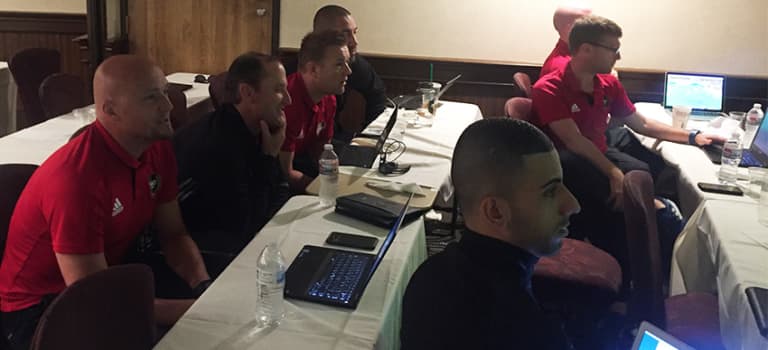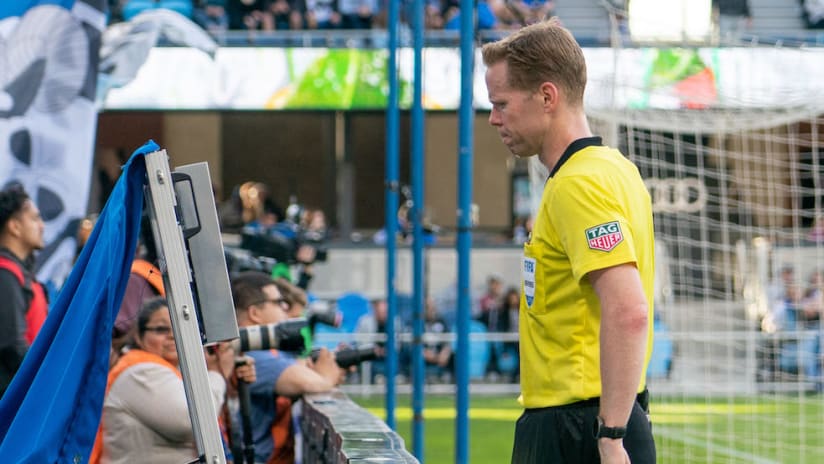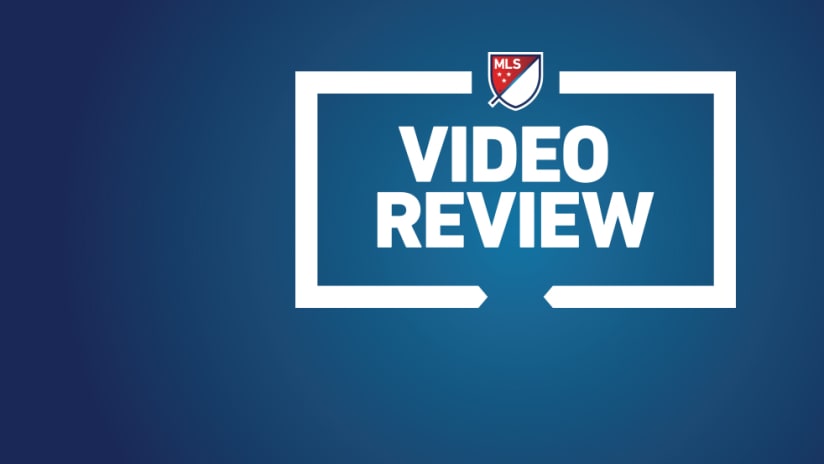Video Review launches in Major League Soccer beginning in Week 22 on Saturday, August 5. Will Parchman spent three days embedded with MLS referees during their most recent Video Assistant Referee training camp organized by the Professional Referee Organization (PRO) in Utah.
PARK CITY, Utah – Howard Webb is animated. Webb, in reality, always seems animated these days.
The statuesque Englishman who became perhaps the most famous referee in the world before his retirement in 2014, dances and gesticulates in front of a video screen in a nondescript hotel conference room. Here he glides to his left, pantomiming a foul call to stoke a debate. In seemingly the same breath, he’s excitedly making a point while miming a rectangular symbol with his hands, a technological signal with which MLS fans in particular are about to become quite familiar.
Rows of rapt referees in white PRO polos are splayed out on tables all leaning forward on their elbows, watching Webb guide a discussion rapidly quickening in intensity.
The clip on the screen for review is from an MLS match on June 10 between the Montreal Impact and Sporting Kansas City. Specifically, it’s a moment late in the second half when Montreal’s Chris Duvall slams into SKC’s Roger Espinoza. On the day, the collision earned Duvall a straight red (watch it below). Robert Sibiga, the ref who sent him off that day, is watching the clip from the fourth row along with everyone else.
The debate about the call orbits around the potential use of Video Review and the Video Assistant Referee (VAR) – which is the reason these 49 referees from PRO, the refereeing organization that provides MLS its referees, are here.
MLS is instituting Video Review for the rest of the season beginning Aug. 5, a pioneering move that puts the league on the cutting edge of potentially the most groundbreaking technology ever introduced into the game. MLS is part of a worldwide opt-in program running through 2018 that’ll lead to a FIFA assessment on the viability of Video Review. In addition to a few others, the German Bundesliga and Italian Serie A are also adopting Video Review for all their domestic matches from the beginning of the 2017-18 season.
Video Review in action
After using Video Review in USL matches and in dry runs during MLS matches, these PRO refs are sandwiched between the mountains in Park City in mid-July for a final boot camp before the official MLS rollout. In short, they’re here to stress the system to such a degree that surprises come launch time are rare.
The debate in the conference room on this day centers around whether the VAR would’ve flagged a clear and obvious error by the referee in the case of Duvall’s red. As his shoulder dips into Espinoza’s sternum, Duvall’s right elbow seems to flare out toward Espinoza’s face. At the time, Sibiga pulled the red because he saw violent conduct from his admittedly imperfect vantage. But on second glance, a month later and with the benefit of replay, the referees almost unanimously agree Duvall’s red was too harsh.
“I wish I had another look during the game,” Sibiga tells the room, “because I would’ve rescinded the red card.”

MLS referees take in a Video Review-related presentation at VAR training camp in Park City from July 10-12.
Webb, a vibrant bundle of energy, nods and bounces at his point. This, he thinks, is the reason Video Review exists. And it's the reason he believes in it so stridently.
At its roots, Video Review's ultimate aim is to narrow a microscope on four of these sorts of major calls that irrevocably alter the trajectory of a game – what the protocol defines as "match-changing incidents."
With a personal archive of experiences from a 21-year refereeing career that included presiding over a World Cup and a UEFA Champions League final in the same year, Webb arrived in February and assumed control of PRO’s push to integrate Video Assistant Referee training in time for the official Aug. 5 rollout.
Practically, the most pervasive alteration is off the field, shielded from public view.
During every MLS game, there will now be a Video Assistant Referee watching the match in real time from a booth in the stadium next to a video technician. They’ll monitor the game on a main screen with a touchscreen underneath it featuring four more camera angles swapped in and out based on the best view at any given time.
This fifth referee, who’s connected to the head ref via microphone, is watching for four reviewable plays: goals, penalty kicks, straight red cards and cases of mistaken identity. Calls involving anything else untethered to any of those four categories are left to the discretion of the head ref, as usual.
After an event involving one of those four criteria takes place, the booth immediately churns into a tide of activity. The VAR flicks the attention down to the touchscreen to manipulate as many camera angles as the stadium provides to get the best look on replay as it immediately rolls back. If there’s no infraction, the VAR notes “check complete” to the on-field head referee and the match goes on as usual, almost always without an unusual stoppage.
“It can get stressful in there,” Sibiga says.
But if that VAR check is one that leads to something bigger – if the VAR thought Sibiga made a clear and obvious error by showing Duvall a red, for instance – the head referee on the field will be alerted and a Video Review will be recommended based on the available replays. The head referee on the field can either accept the VAR’s opinion sight unseen, or look at the plays from a sideline monitor and make a decision based on video evidence. The head referee on the field always has the option to ask for a second opinion from the VAR, but Webb thinks those instances will likely be far fewer in volume.
Assuming Sibiga wanted another glimpse of the foul based on the VAR’s recommendation, he would’ve stopped play to trot over to a video screen set off to the side of the field to give the play a second look, beamed in from the VAR. Had Sibiga rescinded the red, Duvall would’ve been assessed a yellow card and stayed on the field. The match, from there, would’ve continued as normal.
How Video Review changes the game

Professional Referee Organization's Howard Webb delivers a presentation on Video Review.
In Park City, the group of refs on hand continually ran through all the permutations from the point of view of a Video Assistant Referee. Was this a foul? Should you send that play down to the on-field referee for Video Review? And how do you deal with real-time VAR scenarios in which we attempt to throw every infraction in the book at you at once?
An overarching point in these exercises that Webb wanted to impress, ultimately, is that the referee on the field is still the final arbiter. The VAR’s entire aim is to provide more angles and opportunities for the head ref to look at a game-shifting call from a fresh vantage. But it's ultimately the referee's decision what to ultimately do with that information.
“It's like comparing literature, where you can read something and you can interpret it one way or a different way,” Sibiga says. “On the field [as head referee], you can interpret the situation because it’s your angle, you had a split second to make that decision and you made the decision and stick by it.
"With the VAR [in the booth], it’s very binary. It’s either this or that [was it a clear and obvious error or not?]," Sibiga continues. "There’s no room for interpretation, or at least there shouldn’t be. There’s still some decisions that have to be interpreted, but you have more angles. You see things differently and you have to, at the end of the day, make a decision whether the referee made a clear and obvious error.”
The most pervasive concern about VAR, or at least the loudest rumblings from fans, is that it’ll fundamentally alter the DNA of the game by injecting a series of halting stops for reviews that rob soccer of its trademark flow. Webb understands these fears, but is equally quick to wave them off based on the evidence so far.
PRO compiled the numbers from VAR’s first 90 matches in action, a series of MLS offline test runs, USL matches, Generation adidas Cup matches and more. Video Reviews happened roughly once every three games, or 0.36 reviews per match.
In games when Video Review was utilized by the referee on the field, it added one minute and 16 seconds to the game. That worked out to about 26 seconds spent in Video Review per match.
PRO did mock trials with the equipment over three MLS matchdays during the 2017 regular season and got similar results. In 29 test games, Video Reviews were only triggered in 11 of them.
“I think the expectation is that every decision will be reviewed and questioned, and that’s not the case,” says Alan Kelly, who refereed the 2016 MLS Cup final and was on hand for the Park City camp. “Once it’s rolled out, and we’re aware that there’s an explanation as to what we’re doing with Video Review, hopefully that transcends to all the stakeholders in the game, from players to coaches to fans to casual observers.”
But there’s still the human element, the fear that this technology might irrevocably change soccer as it’s been known since time immemorial. That too Webb understands, but he’s just as quick to push back.
Video Review is not being implemented to re-referee the game. Rather, according to its handlers, it exists to help avoid the glaringly bad ones that outwardly influence games, generate headlines and cause heated debate, sometimes for decades. Things like noxiously poor offside calls that lead to unjust goals, or improperly assessed penalties, or even red cards assessed to the wrong man.

The Video Operations Room (VOR) in use during a VAR camp in Park City, Utah hosted by the Professional Referee Organization.
Webb doesn’t want the public to think of Video Review being used to pour over niggling calls and restarts. Not only is that not part of its protocol, it isn’t in the spirit of the technology.
To illustrate the point, Webb launches into an example from his past as a referee. In the 2010 World Cup final between Spain and the Netherlands that he refereed, Webb was faced with an iffy penalty call in extra time with the teams deadlocked. He waved it off.
“Nobody remembers it,” Webb says. “It was a judgment call.”
But the one everyone does remember was Nigel de Jong’s flying kick to Xabi Alonso’s chest (watch below). Webb was positioned awkwardly on the play, hidden from the contact by Alonso’s back, and he only issued a yellow instead of a producing a red. It’s a decision he’s since said he missed.
If Webb had the benefit of a look on Video Review after the fact, de Jong would’ve been off to an early shower with a straight red. Given the incident occurred in the 23rd minute, the Netherlands would’ve – and should’ve – played 67 minutes of regulation time in a World Cup final down a man.
That, Webb says, is far more illustrative of the point of Video Review than the questionable penalty decision that a VAR booth would most likely have bypassed had it been there given the absence of the clear and obvious error trigger.
To land the point a bit closer to home for US men's national team fans, Torsten Frings’ handball on the goal line to egregiously deny the US a goal in the 2002 World Cup quarterfinals is directly in the VAR’s wheelhouse. It would never have stood.
“I’ve refereed over 500 professional games, and I would’ve liked (VAR) in my games,” Webb says. “I can think of various situations where I made a call and my gut feeling tells me fairly quickly after having made the call that that wasn’t quite how I saw it at full speed, and there was something else that I’ve not seen that I’m not party to. It would help me make a better decision and avoid making a clear error. If I’d have been able to speak to somebody and say 'How does that look?' it would’ve been nice.”
Video Review will not fix every call. That was never in its remit to begin with. It’s merely an additional tool provided to the head referee with the chance to overturn a clear error or address a glaring miss to rectify some notable piece of on-field injustice. If the VAR technology provides PRO with those abilities, as its handlers believe it will, then FIFA will likely have a future technological cornerstone of the game on its hands.
“I’ve been involved in soccer for a long time, and up until a couple years ago I’d have considered myself very much a traditionalist when it came to refereeing, that human error is part of the game,” says Kelly. “Over the course of the last number of years, as technology has affected the game for the better, I’ve changed my opinion in terms of technology’s introduction.
“This is the single biggest change to soccer in the history of the game. To be a part of it from what was a blank canvas back in January of 2016 and to see how it’s manifested itself into what it is up until we go live with it on August 5th, it’s been really interesting to see how it’s developed. I’ve thoroughly enjoyed it. There’s always going to be skepticism, but we’ve really embraced it.”
That’s a sentiment that many on these shores are hoping the rest of the world is soon about to understand.











